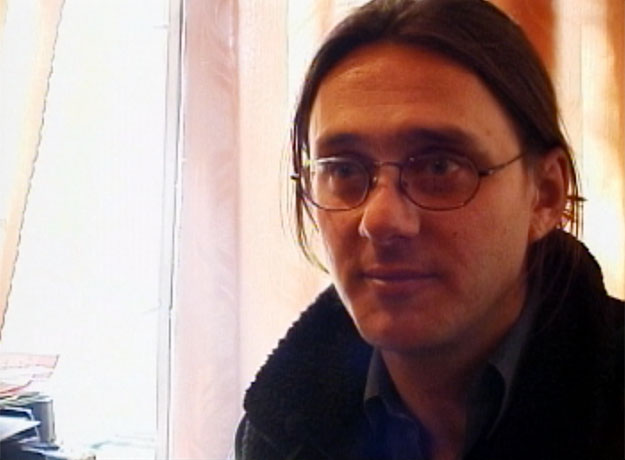
Power Trip
The 21st-century condition of globalization, with all its promise and peril, was a theme that ran through many of the films at this year’s San Francisco International Film Festival and resonated with the mostly local audiences. The collapse of the Soviet Union, of course, has been a prime catalyst for millennial melancholia, and Paul Devlin’s Power Trip, a documentary on the privatization of electrical power in the former Soviet state of Georgia, captures the frustrations of life in a transition economy. When Georgia’s state power company is bought by AES, an American corporation, Georgians must suddenly pay for electricity. At the start of the film, 90 percent of the company’s customers have been disconnected for non-payment of bills (a monthly bill is half the average Georgian’s monthly income), and AES’s offices are overflowing with angry, confused people. But the problems predate capitalism: Georgia’s president is a former KGB agent, and the Ministry of Energy is corrupt. Investigative reporters who begin to expose the inner workings of the system are murdered; poor Georgians who can’t afford the electric bills hook up deadly bird’s nests of live wires to their apartments. Much of the films—hot with available light—is suffused with a dark orange glow: power, diverted illegally to government-favored corporations, goes out regularly in Georgia. To both its benefit and detriment, Devlin’s film relies on interviews with foreigners (from America and England) and educated, English-speaking Georgians (for whom the monthly power bills are more manageable) to illustrate the depths of the country’s corruption. We don’t hear much from the (non-English-speaking) people who have been literally and figuratively left in the dark, but those who are interviewed give a distinct sense that there’s a new generation emerging in Georgia, one determined to figure out how to make the country function.
The promise of a new generation was central to another documentary selection, Thierry Michel’s Iran, Veiled Appearances. Beginning with a pocket history of modern Iran from the Shah onwards, Michel’s film looks at the push and pull of religious and secular factions in the world’s first Islamic republic. Like Mobutu, King of Zaire, Michel’s 1999 film, Iran is a thorough, methodical inquiry, dedicated to the tenets of balanced journalism even as it frames a polemic in favor of democracy. Alongside visitors to the Ayatollah’s tomb and the families of young men who died in the Iran-Iraq war, Michel films high school students who spend Fridays in the mountains consorting with the opposite sex, and a group of girls on a weekend parasailing expedition. Iran demonstrates martyrdom’s potency as a political tool, not just for the reactionary establishment, with its suicide bombers and war martyrs, but for the progressive opposition as well, whenever students are jailed for defending freedom of speech.
Although the program notes suggested it would be a standard reportage-documentary about Afghanistan, Heiner Stadler’s Eat, Sleep, No Women proved to be one of the festival’s most aesthetically and politically challenging films. It narrates a series of events that ostensibly take place all over the world on October 7, 2001, the day the U.S. started bombing Afghanistan. But what appears to be a traditional, linear documentary soon reveals itself as an unabashedly arrogant essay on the globalization of people and images. Eat, Sleep is a feat of time travel: culled from footage shot over a period of ten years, it follows American journalists in Afghanistan and an American travel writer in Hong Kong, gold miners in Brazil, Egyptian pop star Muhammad Mounir at a recording session in Cairo, an artist who paints movie posters in Pakistan, and tracks other threads set in Germany, Northern Ireland, Libya, Beirut, Israel, New York, Paris, and Johannesburg. Stadler grafts these narratives (real or fictional—we never know) onto 10/7/01, taking us on an immense global journey in a matter of hours. Stadler is a veteran photographer and cameraman, and it comes as little surprise that his beautifully photographed film is preoccupied with images and image-making, an interest that positions him in a cinematic lineage that includes fellow German film-essayist Harun Farocki.

Fear and Trembling
The Castro, San Francisco’s Art Deco movie palace, was the ideal place to see Flora Gomes’s theatrical musical, My Voice, a series of colorful song-and-dance numbers whose narrative seems somewhat incidental. The film’s young protagonist, Vita (Fatou N’Diaye), leaves her home in Guinea-Bissau to study in Paris, where she breaks an ancient curse that dooms any female member who sings. Ritual and custom—along with healthy doses of prejudice and superstition—rule, both in France and in Africa: a man is bullied by a small-time criminal into carrying the bust of a national hero until a suitable spot is found for it, and consequently wheels the statue around in a baby carriage for five years; the French are un-learning their racism—slowly. But Gomes’s infectious musical numbers, like Vita herself, seem determined to break free from the constraints of tradition and turn an off-kilter world upside down. Watch out for an extraordinary array of coffins in the third-act finale.
The prodigal daughter theme also ran through Alain Corneau’s Fear and Trembling, a taut, energetic comedy adapted from Amélie Nothomb’s autobiographical novel about a young Belgian woman, born in Japan, who returns to Tokyo after college to work for a cutthroat Japanese corporation. Amélie (Sylvie Testud, one of France’s most talented actresses) breathlessly takes in stride whatever bizarre tasks the corporation throws her way—she’s punished for showing initiative by being forced to add together un-addable numbers for days on end; finally, she ends up as a bathroom attendant. Scored to Bach’s Goldberg Variations, Fear and Trembling is ultimately a film about structure and the way radical elements are tolerated within functional systems. Bach’s order and mathematical control dovetail with the tradition and arcane customs of the Japanese business world—a world from which Amélie remains blissfully isolated.
Ema, the 17-year-old protagonist of Czech director Benjamin Tucek’s Girlie, is another study in isolation. Living with her widowed mother on the outskirts of Prague, taking one disaffected lover after another, she frequents secondhand clothing stores and hairdressers in a typical teenage quest to be different yet connected. (Her mom’s on the same mission.) While it takes cues from the absurdist New Wave cinema of Chytilová and Menzel—mother and daughter perform theatrical calisthenics on the roof of their apartment building; a man tries to prove to his wife that he can fit an entire lightbulb in his mouth—Girlie is nevertheless a film about life in a changing Prague, Prague now, whose socialist housing complexes seem colder and grayer in contrast to Ema’s constantly-changing hairstyles and costumes. Tucek’s debut is one among many promising new features from the Czech Republic (and the first shot in hi-def video) and evidence of new cinematic life in the country.

Whale Rider
Another entry in the “Young Woman Defying Tradition” genre was Whale Rider, which, despite my best efforts at self-restraint, left me in tears. Having spent 12 out of the first 13 weeks of its New Zealand release at the top of the charts, Niki Caro’s debut is a proven crowd-pleaser. Set in a Maori village facing poverty and the erosion of its traditions and social cohesion, Whale Rider follows a well-worn narrative path—a demoralized community searches for a spiritual leader to heal it, aforesaid leader embarks on a journey of self-realization. The film’s secret weapon is its remarkable lead actress, 12-year-old Keisha Castle-Hughes, who plays Paikeia, a tomboy born with a mystical sensibility—spirited and expressive, with a remarkable emotional range, Castle-Hughes is a find.
Robert Altman received the San Francisco Film Society’s Lifetime Achievement Award, and on my first day at the festival, I, along with about ten others, made it to a screening of Tanner ’88, Altman’s classic satirical HBO miniseries (written by Garry Trudeau), which follows the presidential primary campaign of the eponymous Jack Tanner (Michael Murphy) as he crisscrosses New Hampshire in a Jeep driven by his daughter (Cynthia Nixon). Sure, the story is clumsy at times, the characters broadly sketched, and the video technology now quaintly dated. But the upstart-Democrat-from-New-England narrative couldn’t have been more timely or resonant. In a festival with an eye to a widening world, stories about home really matter. And any film (or TV series) in which Pat Buchanan, Gary Hart, and Bob Dole all have cameos is okay in my book.








